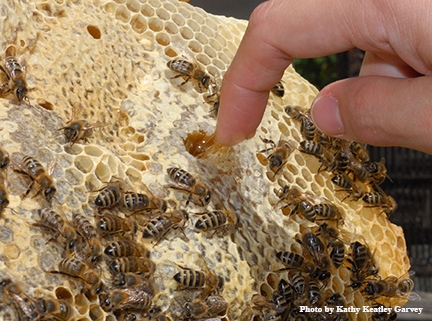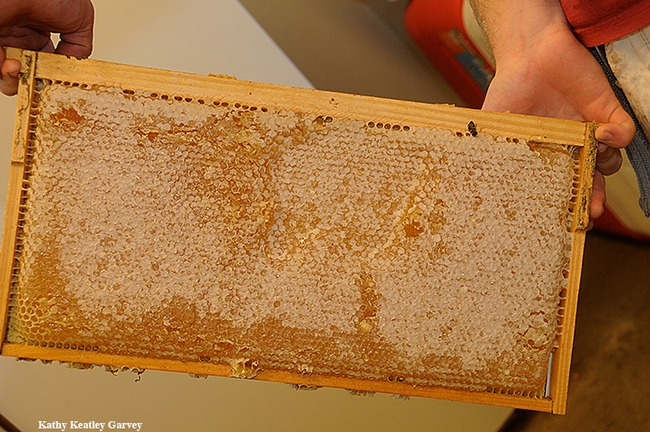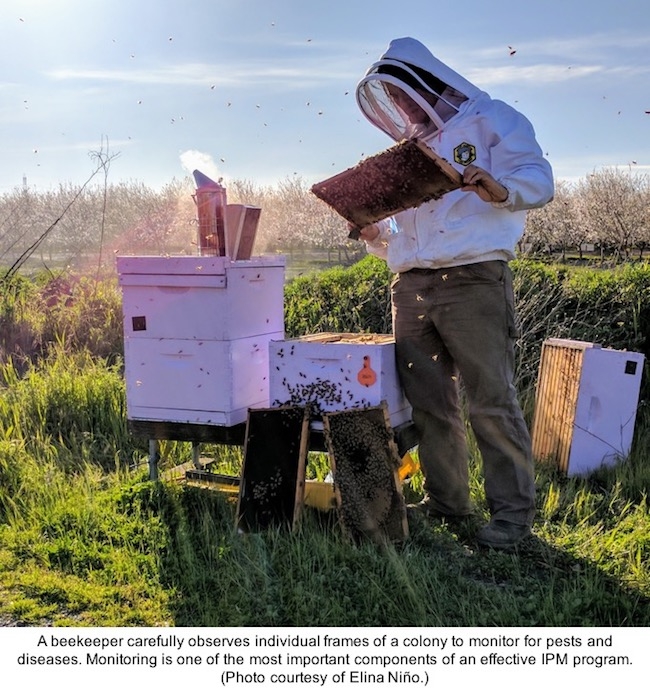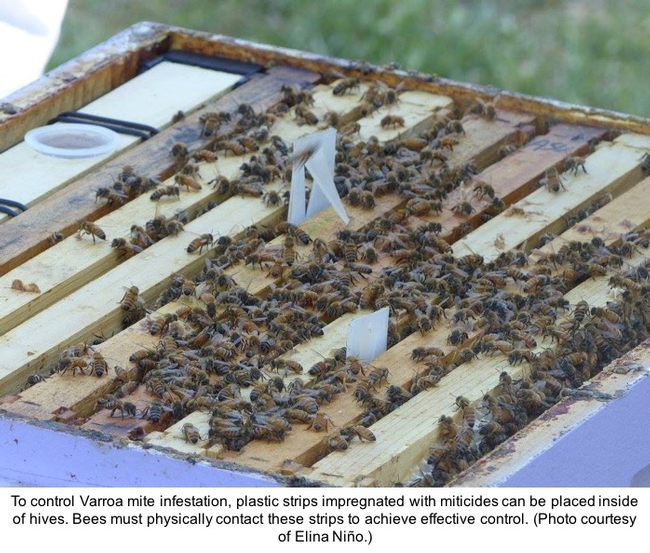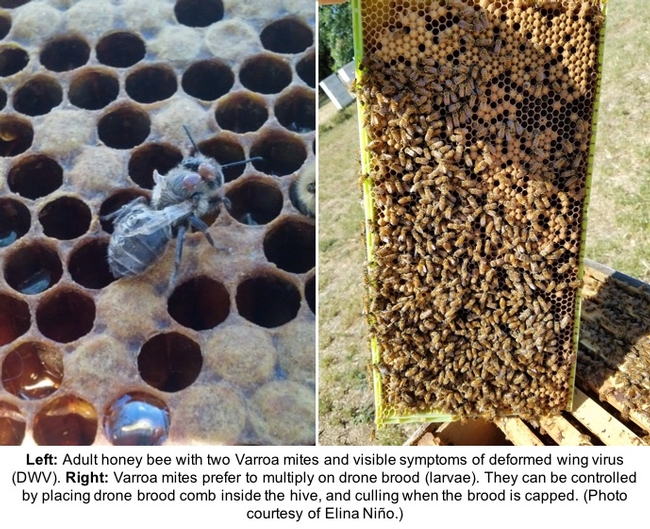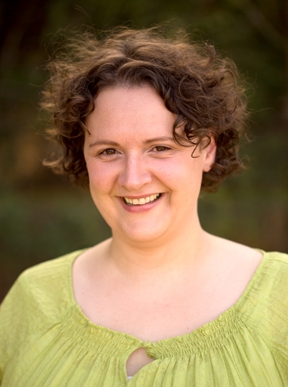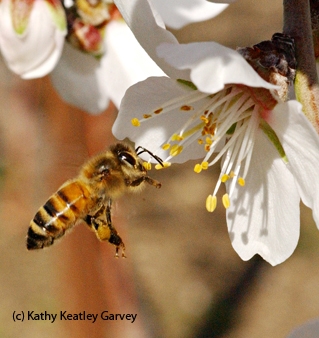Posts Tagged: Elina L. Niño
Honey: Nothing short of miraculous
“Honey, please pass the honey!”
That simple request, prefaced with a term of endearment for good measure, means there's honey on the table.
And well there should be. As the daughter, granddaughter and great-great granddaughter (and beyond) of beekeepers, I grew up with honey on the table. (And on my fingers, face and clothes.)
My favorite then was clover honey from the lush meadows and fields of our 300-acre farm in southwest Washington. My favorite now is Northern California yellow starthistle honey, derived from the blossoms of that highly invasive weed, Centaurea solstitialis, which farmers hate (and rightfully so) and beekeepers love.
“Almost every honey has its own unique flavor-- even when it is the same varietal,” says Amina Harris, director of the UC Davis Honey and Pollination Center. “There are characteristics we learn to look for, but even within that variety, the honey will differ from each area collected. For instance: avocado honey is known for being very dark amber with a flavor reminiscent of molasses, licorice or anise. However, once you start tasting a selection, some will taste like blackstrap molasses and very black licorice. Others will have almost a fruity flavor like dried figs or prunes. Most folks can't tell the difference – and then there are the honey nerds, like me!”
“My favorite all-around honey is one I keep returning to. I love sweet clover from the High Plains with its cinnamon hit —the spicy characteristic is just something I love,” Harris said. “My favorite ‘shock honey' is coriander. Collected near Yuba City, this seed crop gives us a honey that is like walking through a spice bazaar with hints of cardamom, cinnamon, allspice, nutmeg, coriander and — chocolate.”
The UC Davis Honey and Pollination Center, located in the Mondavi Institute for Wine and Food Science on Old Davis Road, periodically offers courses on the sensory evaluation of honey, as well as honey tastings. Next up: the center will host free honey tastings at its home base during the 105th Annual Campuswide Picnic Day on April 13, and at the California Honey Festival in downtown Woodland on May 4. Another popular honey tasting: California Extension apiculturist Elina Lastro Niño, based in the UC Davis Department of Entomology and Nematology, hosts a honey tasting at Briggs Hall during the annual Picnic Day.
There's more to honey than meets the eye — or the palate. The Honey and Pollination Center recently hosted a three-day Sensory Evaluation of Honey Certificate Course last October, using “sensory evaluation tools and methods to educate participants in the nuances of varietal honey,” Harris said. Northern California public radio station KQED spotlighted the course on its “Taste This” program.
And we owe it all to honey bees.
Pollination ecologist Stephen Buchmann of the University of Arizona (who received his doctorate in entomology from UC Davis, studying with native pollinator specialist Robbin Thorp), writes in his book, Honey Bees: Letters from the Hive, that each worker bee “may make four to ten or so flights from the nest each day, visiting hundreds or many thousands of flowers to collect nectar and pollen. During her lifetime, a worker bee may flown 35,000 to 55,000 miles collecting food for her and her nest mates. One pound of honey stored in the comb can represent 200,000 miles of combined bee flights and nectar from as many as five million flowers.”
Take a 16-ounce jar of honey at the supermarket. That represents “the efforts of tens of thousands of bees flying a total of 112,000 miles to forage nectar from about 4.5 million flowers,” writes Buchmann.
Of course, we primarily appreciate honey bees for their pollination services (one-third of the food we eat is pollinated by bees) but honey is more than just an after thought.
It's been described as “liquid gold,” “the nectar of the gods” and “the soul of a field of flowers.” Frankly, it's nothing short of miraculous.
And well it should be.
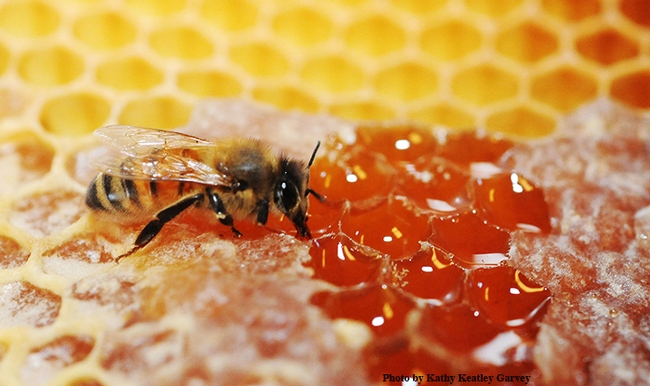
A honey bee sips honey from honeycomb. (Photo by Kathy Keatley Garvey)
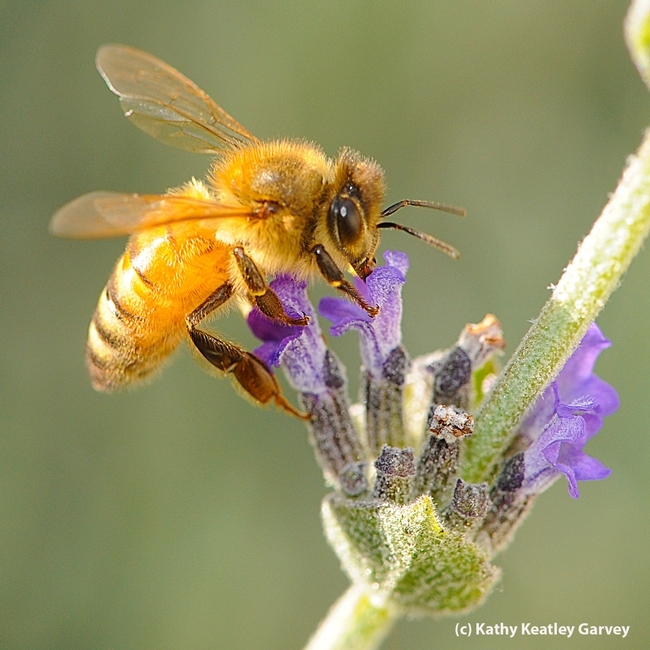
A honey bee sips nectar from a lavender blossom. (Photo by Kathy Keatley Garvey)
August 19th is National Honey Bee Day: Dr. Elina Niño reminds us to help honey bees cope with pests
National Honey Bee Day is celebrated on the third Saturday of every August. This year it falls on Saturday the 19th. If you use integrated pest management, or IPM, you are probably aware that it can solve pest problems and reduce the use of pesticides that harm beneficial insects, including honey bees. But did you know that it is also used to manage pests that live inside honey bee colonies? In this timely podcast below, Elina Niño, UC Cooperative Extension apiculture extension specialist, discusses the most serious pests of honey bees, how beekeepers manage them to keep their colonies alive, and what you can do to help bees survive these challenges.
https://soundcloud.com/ucipm/help-honey-bees-cope-with-pests
To read the full transcript of the audio, click here.
Successful IPM in honey bee colonies involves understanding honey bee pest biology, regularly monitoring for pests, and using a combination of different methods to control their damage.
Visit the following resources for more information
For beekeepers:
For all bee lovers:
- EL Niño Bee Lab Newsletter
- Haagen Dazs Honey Bee Haven plant list
- UC IPM Bee Precaution Pesticide Ratings and video tutorial
Sources on the value of honey bees:
- Calderone N. 2012. Insect-pollinated crops, Insect Pollinators and US Agriculture: Trend Analysis of Aggregate Data for the Period 1992–2009.
- Flottum K. 2017. U.S. Honey Industry Report, 2016.
California: A good place to bee
“Honey bees are good teachers and we can all learn from them,” says Elina Lastro Niño, the new Cooperative Extension apiculturist for UC Agriculture and Natural Resources. “Each hive has its own personality and own temperament.”
Niño, based at UC Davis, is as busy as the proverbial worker bee during a colony's spring build up as she settles into her new position involving research, education and outreach.
“California is a good place to be,” she said. “I just wish I could have brought some of that Pennsylvania rain with me to help out California's drought.”
Her lab not only aims to conduct applied research that leads to practical solutions, but to alert the state's beekeepers about new research, and develop web-based educational tools. She writes the bimonthly newsletter, “from the UC apiaries." (See her newsletter section on her website, and see the archived editions by Eric Mussen on his website). In addition, she will be serving on various advisory boards to allow “us to guide decision making and legislation based on the most up to date scientific information.”
Niño operates her field lab at Harry H. Laidlaw Jr. Honey Bee Research Facility on Bee Biology Road, west of the central campus. She also maintains a lab and office in Briggs Hall. Her aims: to conduct practical, problem-solving research projects; to support the state's beekeepers through research, extension and outreach; and to address beekeeper and industry concerns.
Niño, who studies honey bee biology, health, reproduction, pollination biology, insect ecology, evolution, genomics and chemical ecology, replaces Eric Mussen, who retired in June 30 after 38 years of service.
“Elina is a very accomplished scientist,” said Mussen. “Her research involves the reproductive processes involved in queen bee mating, including the impacts of oviduct manipulation, insemination volume and insemination substances. The induced changes include measurable behavioral, physiological and molecular alterations that occur, including differences in behavioral interactions between queens and worker bees.”
Niño has already met with many of the state's beekeepers, attended meetings of the California State Beekeepers' Association, the California Bee Breeders' Association, and the Almond Board of California, and charmed youngsters from the California School of the Blind, Fremont, who asked many questions about honey bees.
“I love meeting people,” she said. She delights in answering questions, including those from inquisitive school children.
One of the most common questions: “Do you get stung?” Answer: “Yes, many times.”
Some don't know that all worker bees are females, that they do all the work. They are fascinated with the queen bee, which can lay as many as 2,000 eggs a day during peak season. Once a youngster, thinking about the queen bee, asked: “What happened to the king?”
Bees are in a global decline due to pesticides, parasites, pests, malnutrition and stress. Niño says most people have heard of colony collapse disorder, and many know that the average beekeeper loses approximately 30 percent of the colonies each winter due to the combined effect of various pests, pathogens, environmental toxins, and poor nutrition.
“My research and extension goals are to provide stakeholders with practical tools that better equip them to confront these challenges. My primary research focus is to characterize biological factors that regulate honey bee queen reproduction. By better understanding these factors, we can improve the honey bee breeding protocols necessary for creating and maintaining resilient honey bee stock.”
Elina Niño wasn't always so totally devoted to bees. Born and reared in Bosnia in Eastern Europe, Elina moved to the United States with plans to become a veterinarian. She obtained her bachelor's degree in animal science at Cornell University, but while there, enrolled in an entomology class on the recommendation of her advisor. “I was hooked,” she recalled.
Following her graduation from Cornell in 2003, she received her master's degree in entomology from North Carolina State University and her doctorate in entomology from Pennsylvania State University. While at Penn State, she sought to add to her applied-research expertise and gain experience in basic research. She joined the honey bee lab of Christina Grozinger, who studies the genomics of chemical communication and collaborates with researcher David Tarpy on understanding queen bee post-mating changes.
After attending her first lab meeting, “I was hooked again!” Niño recalled.
She and her fellow researchers confirmed that carbon dioxide causes queens to stop attempting mating flights and helps them start producing eggs. They also found that instrumental insemination triggers changes in Dufour's gland pheromone. Understanding the regulation of reproductive processes can lead to better management practices for improved colony productivity and health, Niño said.
Niño is now settled in Davis with her husband, Bernardo Niño, a former senior research technologist in the Grozinger lab and now a staff research associate at the Laidlaw facility; their toddler son, Sebastian; and their dog, a Doberman named Zoe. Bernardo, who managed some 40 to 50 colonies at Penn State, received his bachelor's degree in biology from St. Edward's University, Austin, Texas; and his master's degree in entomology from North Carolina State University, Raleigh.
Elina is building up her research team, which includes Bernardo; and staff research associate Billy Synk and doctoral candidate W. Cameron Jasper of the Brian Johnson lab.
“We view ourselves as the liaison between the beekeepers and other relevant growers and the scientific community,” Elina said. “We are continuing research on queen mating and reproduction, especially considering the importance of Northern California beekeepers for the queen rearing and bee breeding enterprises.”
They will expand their work to include studies “crucial for supporting honey bee health.” Current collaborate work includes examining the effects of Israeli Acute Paralysis Virus, Deformed Wing Virus and Nosema gene expression regulation and longevity in workers. Understanding the molecular mechanisms that underlie individual responses to specific honey bee pathogens, Elina said, “can lead to the implementation of appropriate beekeeping practices.”
“In the near future, we plan to contribute to the general understanding of synergistic effects of pesticides on honey bee health and collaborate on research evaluating alternative Varroa mite control.”
How would she describe herself? “Like a rock. I don't get easily disturbed. There's not a lot that fazes me. I find a way to figure out a problem and find a solution.”
Now she and her “Bee” team--that is, Bernardo and Billy--are gearing up for their inaugural queen bee rearing short-course March 28-29 at the Harry H. Laidlaw Jr. Honey Bee Research Facility. She will continue teaching these short courses to beekeepers with basic bee experience who want to learn more about rearing queens.
Another pending activity: she'll be judging the California 4-H Honey Bee Essay Contest, “Planting for Bees from Backyards and Up” (http://preservationofhoneybees.org/essays). The contest closed Feb. 20.
Meanwhile, Niño has set up her lab's website at http://elninobeelab.ucdavis.edu/; a Facebook page at https://www.facebook.com/elninolab and has obtained an easy-to-remember email in the form of "el nino": elnino@ucdavis.edu.
“California is a good place to be,” she reiterated.
An initiative to enhance competitive and sustainable food systems is part of UC Agriculture and Natural Resources Strategic Vision 2025.
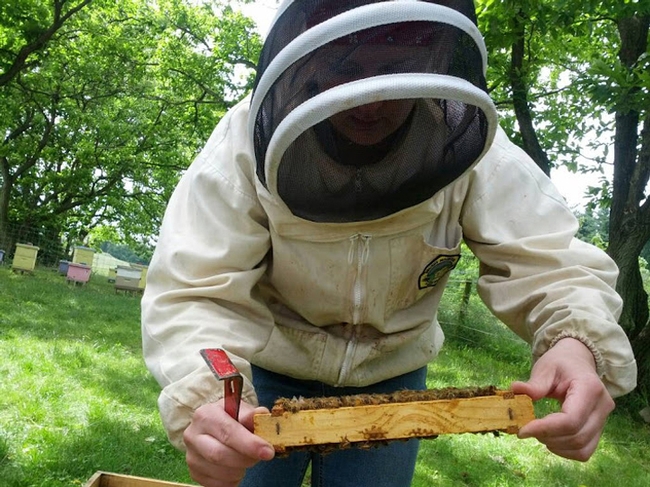
Elina Lastro Niño working a hive. (Photo courtesy of Elina Lastro Niño)

